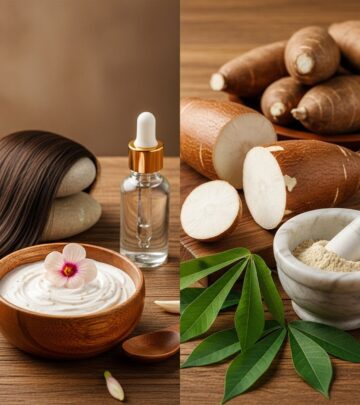Hydrogenated Soybean Oil: Cosmetic Ingredient Profile and Uses
Explore the benefits, functions, safety, and regulatory aspects of Hydrogenated Soybean Oil in cosmetics and personal care.

Hydrogenated Soybean Oil: Cosmetic Ingredient Overview
Hydrogenated Soybean Oil is a widely used cosmetic ingredient derived from the soybean plant, Glycine soja or Glycine max. Commonly labeled in ingredient lists as Hydrogenated Soybean Oil (INCI), it is notable for its unique ability to enhance product texture, offer skin conditioning benefits, and stabilize formulas in various cosmetic and personal care applications.
What Is Hydrogenated Soybean Oil?
Hydrogenated Soybean Oil is created by adding hydrogen to soybean oil through a process called hydrogenation. This chemical transformation converts some of the unsaturated fatty acids in soybean oil into saturated ones, yielding an oil that is more solid and stable at room temperature. This makes it especially useful for cosmetic and personal care formulations, as it helps products maintain consistency and shelf life.
- INCI Name: Hydrogenated Soybean Oil
- CAS Number: 8016-70-4
- Chem/IUPAC Name: Soybean oil, hydrogenated
- EINECS/ELINCS No: 232-410-2
- COSING REF No: 34387
Chemical Structure and Appearance
Hydrogenated Soybean Oil appears as a creamy, off-white, waxy substance. The typical chemical formula is C57H106O6. This structure provides stability and moisture-locking benefits in formulations.
Other Soy-Derived Cosmetic Ingredients
Several related ingredients obtained from soybeans are used in cosmetics:
- Glycine Soja (Soybean) Oil: The oil extracted directly from soybeans.
- Soybean Glycerides: A mix of mono-, di-, and triglycerides derived from soybean oil.
- Soy Acid: A mixture of fatty acids from soybean oil.
- Hydrogenated Soy Polyglycerides: Formed by metathesis and hydrogenation processes.
Functions and Cosmetic Benefits
Hydrogenated Soybean Oil is a multi-functional ingredient known for its emollient and skin conditioning roles. Its cosmetic benefits include:
- Emollient – Softens and smoothes the skin, imparting a velvety feel in creams, lotions, and balms.
- Skin Conditioning Agent – Helps maintain the skin in good condition, supporting hydration and barrier function.
- Occlusive Agent – Forms a protective barrier on the skin’s surface to prevent moisture loss.
- Humectant – Attracts and retains moisture within cosmetic formulas.
- Viscosity Controlling – Adjusts the thickness and consistency of cosmetic products, ensuring pleasant texture and ease of application.
- Antioxidant (via Glycine Soja Oil) – Supports product stability by preventing oxidation.
- Surfactant (via Soy Acid) – Helps emulsify and cleanse.
Typical Applications in Cosmetics & Personal Care
Hydrogenated Soybean Oil is found in a broad range of cosmetic and personal care products, including but not limited to:
- Bath products
- Cleansing formulations
- Eye makeup
- Hair conditioners and styling products
- Permanent wave solutions
- Shampoos
- Sunscreen and suntan products
- Lip balms
- Moisturizers and body lotions
Benefits in Skin Care
- Locks in moisture and helps prevent skin dehydration.
- Provides a soft, non-greasy afterfeel.
- Adds barrier protection against environmental stressors.
- Improves skin smoothness and comfort, especially in dry or sensitive skin formulations.
Benefits in Hair Care
- Forms a protective layer over hair strands without heaviness.
- Enhances hair manageability and tames frizz.
- Imparts a silky, hydrated texture to the hair.
Production: The Hydrogenation Process
The creation of Hydrogenated Soybean Oil involves a specific hydrogenation process:
- Liquid soybean oil is exposed to hydrogen gas under heat and pressure conditions.
- Unsaturated fatty acids in the oil are partially or fully converted to saturated fats.
- The result is a more solid, stable product ideal for cosmetic and personal care applications.
This process can be fine-tuned to achieve specific melting points or consistencies required by product formulators.
Plant or Synthetic Origin
While Hydrogenated Soybean Oil is predominantly of plant origin, advanced manufacturing may result in various sourcing and processing methods. The ingredient remains widely recognized as a plant-based alternative in the cosmetic sector.
Functional Table: Hydrogenated Soybean Oil and Related Ingredients
| Ingredient | Main Function(s) | Source |
|---|---|---|
| Hydrogenated Soybean Oil | Emollient, Skin conditioning, Occlusive, Viscosity control, Humectant | Soybean oil (hydrogenated) |
| Glycine Soja (Soybean) Oil | Antioxidant, Skin conditioning (occlusive) | Soybean (plant oil) |
| Soybean Glycerides | Emollient, Skin conditioning | Soybean oil-derived glycerides |
| Soy Acid | Surfactant (cleansing and emulsifying) | Soybean fatty acids |
| Hydrogenated Soy Polyglycerides | Skin conditioning, Viscosity controlling | Soybean oil, hydrogenated polyglycerides |
Regulatory and Safety Information
Hydrogenated Soybean Oil enjoys broad regulatory acceptance and is generally classified as safe for use in cosmetic and personal care products. It is listed by international authorities, including COSING (European Commission database), and complies with standards in various markets, such as the European Union and China.
Safety Profile
- Generally recognized as non-toxic when used in topical cosmetic applications.
- Suitable for all skin types, though patch testing is recommended for individuals with sensitive skin or soy allergies.
- Has not been associated with significant adverse effects when used as directed in cosmetic products.
Certifications and Labeling
- Frequently included in products seeking clean or conscious beauty certifications.
- Subject to labeling requirements depending on local regulations and product claims.
- May be present in vegan and plant-based cosmetic formulations.
Scientific Insights: How It Works in Formulations
- Emollient property arises from its saturated fat profile, which forms a soft, occlusive film on the skin.
- Viscosity modification ensures creams, lotions, and balms have desirable spreadability and texture.
- Combination with other ingredients, e.g., natural oils or butters, enhances the product’s overall sensory experience and stability.
Recent Industry Trends
- Rising demand for sustainable, plant-based ingredients has increased the use of Hydrogenated Soybean Oil in clean beauty products.
- It is favored for its multifunctionality and cost-effectiveness in product formulation.
Frequently Asked Questions (FAQs)
Q: Is Hydrogenated Soybean Oil safe to use on sensitive skin?
A: Yes, Hydrogenated Soybean Oil is generally safe for use on all skin types, including sensitive skin. However, those with allergies to soy should perform a patch test or consult a dermatologist before use.
Q: What benefits does Hydrogenated Soybean Oil offer in skin care products?
A: It acts as an emollient and moisture barrier, softening the skin, preventing water loss, and improving texture without greasy residue.
Q: Can Hydrogenated Soybean Oil be used in natural or clean beauty formulations?
A: Yes, as a plant-derived ingredient, it is commonly found in natural, clean, vegan, and cruelty-free product lines.
Q: What function does it serve in hair care products?
A: It adds manageability, protects hair shafts with a light barrier, reduces frizz, and creates a hydrated, silky finish.
Q: Are there any notable regulatory restrictions for Hydrogenated Soybean Oil in cosmetics?
A: There are no major restrictions when used in cosmetics according to international standards, but products must comply with regional labeling and safety regulations.
Conclusion
Hydrogenated Soybean Oil stands out as a versatile, cost-effective, and well-tolerated ingredient in the world of cosmetic and personal care formulation. Its ability to act as an emollient, viscosity modifier, barrier enhancer, and moisturizing agent ensures its continued popularity across product categories from skin and hair care to decorative cosmetics. With a strong safety profile and growing consumer preference for gentle, plant-based ingredients, Hydrogenated Soybean Oil remains a staple in the formulation chemist’s toolkit for delivering pleasant, effective, and stable cosmetic products.
Read full bio of medha deb











